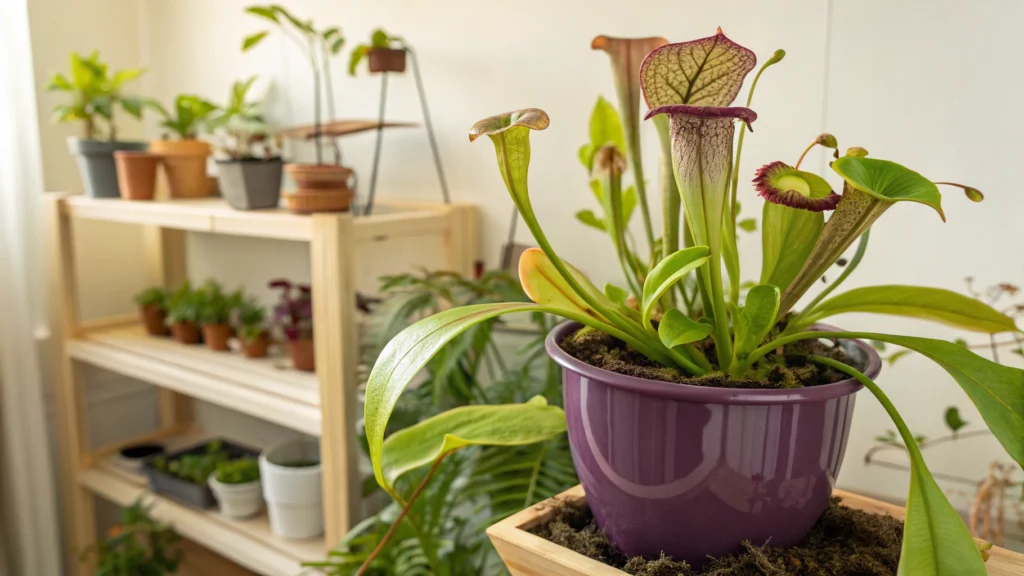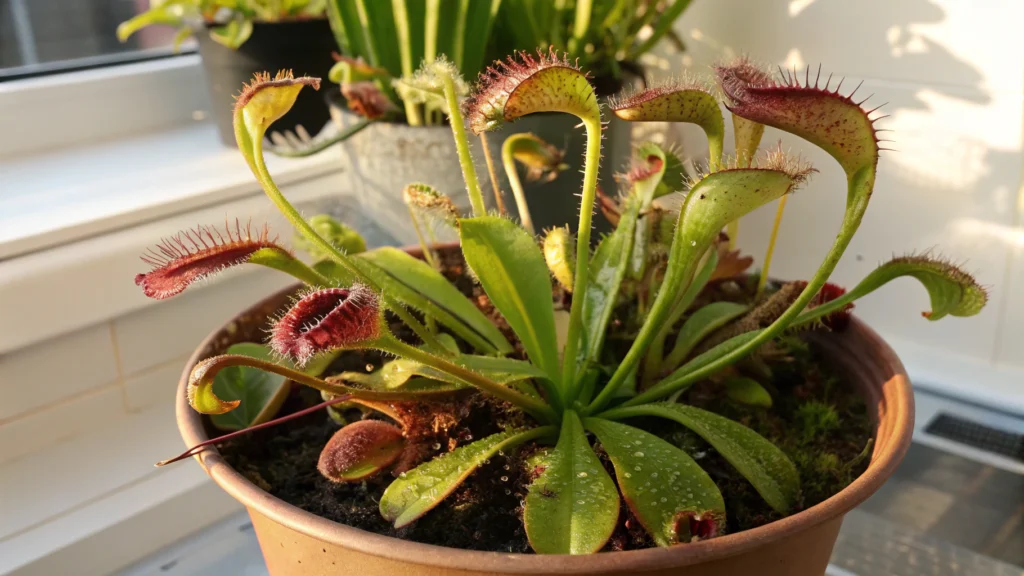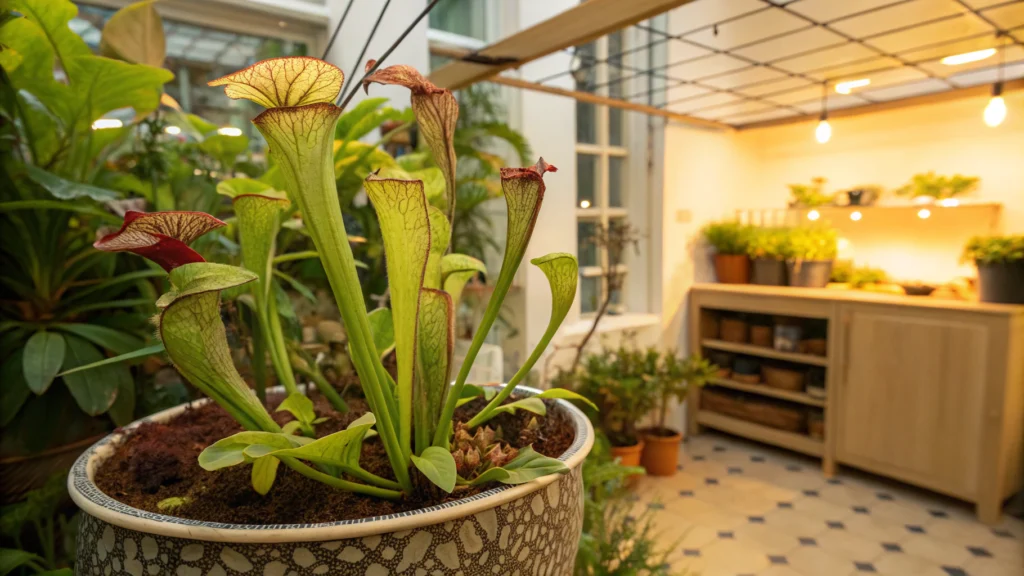Have you ever gazed into the mysterious mouth of a carnivorous pitcher plant and felt a strange connection to this incredible botanical predator? I certainly have. The first time I witnessed a pitcher plant’s elegant curves and vibrant colors, something awakened in me—a fascination with these remarkable living traps that has only grown deeper over the years.
Carnivorous pitcher plants aren’t just plants; they’re evolutionary marvels that have developed ingenious strategies to thrive in nutrient-poor environments. By capturing and digesting insects, these fascinating predators have carved out a unique ecological niche that continues to captivate both casual gardeners and serious botanists alike.
As we approach 2025, growing techniques and understanding of pitcher plants have evolved significantly, making it the perfect time to dive into this rewarding horticultural adventure. Whether you’re a beginner looking to care for your first pitcher plant or an experienced grower seeking to perfect your techniques, this comprehensive guide will equip you with everything you need to succeed.
Table of Contents
Understanding Carnivorous Pitcher Plants: Nature’s Living Traps
Carnivorous pitcher plants belong to several genera including Nepenthes, Sarracenia, and Darlingtonia, each with their own unique adaptations and care requirements. What unites these diverse plants is their remarkable pitfall trap mechanism—modified leaves that form fluid-filled vessels designed to lure, capture, and digest insect prey.
The Fascinating Biology Behind Pitcher Plants
The pitcher plant’s remarkable trapping structure begins as a tiny leaf that gradually unfurls and expands into its characteristic pitcher shape. The inner surfaces of these living vessels contain several specialized zones:
- The attractive zone: Featuring vibrant colors, nectar, and sometimes UV patterns visible to insects
- The slippery zone: Covered with downward-pointing hairs or waxy surfaces that prevent escape
- The digestive zone: Filled with a cocktail of enzymes that break down captured prey
- The absorption zone: Where the plant absorbs the nutrients released from digested insects

Dr. Alison Matthews, botanist at the University of California’s Plant Biology Department, explains: “What makes carnivorous pitcher plants truly remarkable is that they’ve essentially evolved their own external stomachs. This adaptation allows them to supplement their nutrient intake in environments where soil nutrients are scarce.”
Types of Pitcher Plants You Can Grow at Home
| Species | Native Region | Growth Habit | Difficulty Level |
|---|---|---|---|
| Nepenthes × ventrata | Southeast Asia (hybrid) | Climbing/hanging | Beginner-friendly |
| Sarracenia purpurea | Eastern North America | Rosette | Easy to moderate |
| Nepenthes rajah | Mount Kinabalu, Borneo | Large, ground-dwelling | Advanced |
| Cephalotus follicularis | Western Australia | Compact rosette | Moderate to advanced |
| Sarracenia leucophylla | Southeastern United States | Tall, upright | Moderate |
5 Essential Tips for Thriving Carnivorous Pitcher Plants in 2025
1. Mastering the Water Quality Requirements
Perhaps the most crucial aspect of growing healthy carnivorous pitcher plants is understanding their specific water requirements. These specialized plants have evolved in environments with minimal nutrients, making them extremely sensitive to minerals commonly found in tap water.
Why Water Quality Matters for Pitcher Plants
Carnivorous pitcher plants require pure, mineral-free water to thrive. Their natural habitats—whether bogs, cloud forests, or mountainous regions—typically provide them with rainwater or highly filtered groundwater that contains virtually no dissolved minerals.
The ideal water sources for pitcher plants include:
- Rainwater (collected and stored properly)
- Distilled water
- Reverse osmosis (RO) water
- Deionized water
Avoid using these water sources:
- Tap water (contains chlorine, fluoride, and minerals)
- Bottled spring water (often contains minerals)
- Well water (typically high in dissolved solids)
In 2025, advanced home water purification systems have become more affordable and efficient, making it easier than ever to provide your carnivorous pitcher plants with the pure water they crave. Consider investing in a small reverse osmosis system dedicated to your carnivorous plant collection.
2. Creating the Perfect Growing Medium for Carnivorous Pitcher Plants
Another critical factor in successful pitcher plant cultivation is using the appropriate growing medium. Carnivorous plants have evolved to grow in nutrient-poor soils, and conventional potting mixes will quickly kill them.
The Ideal Soil Mix Formula
The perfect carnivorous pitcher plant mix provides excellent drainage while maintaining moisture and remaining low in nutrients. Here’s a proven formula that works exceptionally well:
Basic Pitcher Plant Soil Mix:
- 50% high-quality sphagnum peat moss
- 30% silica sand or horticultural sand (avoid beach sand)
- 20% perlite
For Nepenthes species, consider this specialized mix:
- 60% long-fibered sphagnum moss
- 20% perlite
- 10% orchid bark
- 10% charcoal
For highland Nepenthes varieties, try this mix:
- 70% long-fibered sphagnum moss
- 20% perlite
- 10% horticultural charcoal
Potting Best Practices
When potting or repotting your carnivorous pitcher plant, follow these essential guidelines:
- Use plastic, glazed ceramic, or glass containers with drainage holes
- Avoid terracotta pots which can leach minerals into the soil
- Ensure the container is proportionate to the plant’s size
- Never compress the soil mix too firmly—pitcher plants prefer a somewhat loose medium
- Position the plant at the same depth it was previously growing
3. Optimizing Light Conditions for Maximum Pitcher Development
Light is another crucial factor in growing thriving carnivorous pitcher plants. The quality, intensity, and duration of light directly affect pitcher formation and coloration.
Natural Light Requirements
Most pitcher plant species require bright, indirect light to produce their characteristic pitchers. Insufficient light often results in weak growth and poor trap development.

Light requirements by genus:
- Sarracenia: 6+ hours of direct sunlight daily
- Nepenthes: Bright, indirect light (some morning sun is beneficial)
- Heliamphora: Bright light with protection from intense midday sun
- Darlingtonia: Bright indirect light with cool root conditions
- Cephalotus: Bright indirect light, some morning sun is beneficial
Using Artificial Lighting in 2025
The latest developments in grow light technology have made indoor cultivation of carnivorous pitcher plants more successful than ever before. If growing indoors, consider these advanced lighting options:
Current Recommended Grow Lights for Pitcher Plants:
- Full-spectrum LED grow lights (minimum 20-30 watts per square foot)
- Quantum board LEDs with customizable spectrum settings
- Smart lighting systems that automatically adjust intensity and duration
Position lights approximately 12-18 inches above your pitcher plants and provide 12-14 hours of light daily for optimal results.
4. Mastering Humidity and Air Circulation for Healthy Pitcher Plants
Carnivorous pitcher plants typically thrive in environments with elevated humidity levels, but proper air circulation is equally important to prevent fungal and bacterial issues.
Creating the Perfect Humidity Environment
Most pitcher plant species, particularly Nepenthes, require humidity levels between 50-80% to develop proper pitchers. Here are effective methods to increase humidity:
- Humidity trays: Place pots on trays filled with pebbles and water
- Grouping plants: Creating a microclimate of higher humidity
- Room humidifiers: Modern ultrasonic models designed for plant use
- Growing chambers: Clear plastic or glass enclosures with ventilation
- Automated misting systems: Programmable misting on a timer

The Critical Balance: Humidity vs. Air Movement
While high humidity is beneficial, stagnant air creates perfect conditions for fungal problems. Ensure proper air circulation using these methods:
- Small oscillating fans on low settings
- Strategic placement of plants to allow natural air movement
- Periodic opening of terrariums or growing cases
- Maintaining proper spacing between plants
5. Advanced Feeding Strategies for Spectacular Pitcher Development
Though carnivorous pitcher plants can survive without supplemental feeding, strategic nutritional support can dramatically improve pitcher development and overall plant health.
Natural vs. Supplemental Feeding
In their natural habitats, carnivorous pitcher plants capture insects to supplement their nutrient intake, primarily obtaining nitrogen, phosphorus, and other minerals not available in their growing medium.
Natural prey capture methods:
- Allow your pitcher plants to catch insects naturally if grown outdoors
- Introduce small flying insects like fruit flies to indoor growing environments
- Maintain proper pitcher fluid levels to ensure successful prey digestion
Supplemental Feeding Techniques for 2025
Recent research has refined our understanding of pitcher plant nutrition. Here are the most current supplemental feeding recommendations:
For direct pitcher feeding (apply once per month during growing season):
- Rehydrated bloodworms (1-2 per pitcher)
- Beta fish pellets (1 per pitcher, crushed)
- Dried mealworms (1 small piece per pitcher)
- Specialized carnivorous plant food (follow package directions)
Foliar feeding (apply every 2-3 months during growing season):
- MaxSea 16-16-16 at 1/4 strength (quarter teaspoon per gallon)
- Specialized carnivorous plant fertilizers at recommended dilution
Important: Never apply standard houseplant fertilizers to your carnivorous pitcher plants, as this will damage or kill them. Always use extreme dilution with specialized products formulated for carnivorous plants.
Troubleshooting Common Carnivorous Pitcher Plant Problems
Even with proper care, carnivorous pitcher plants can sometimes develop issues. Here’s how to identify and address the most common problems:
Pitcher Formation Issues
Problem: Plant isn’t producing pitchers
Possible causes:
- Insufficient light
- Humidity too low
- Inconsistent watering
- Temperature fluctuations
- Nutrient-rich soil or water
Solution: Ensure the plant receives proper light, maintain consistent humidity above 50%, use appropriate water, and verify your growing medium is suitable for carnivorous plants.
Leaf and Pitcher Discoloration
Problem: Brown or black spots on pitchers
Possible causes:
- Sunburn
- Mineral buildup from improper water
- Fungal infection
- Natural aging
Solution: Adjust light exposure, verify water quality, improve air circulation, and remove severely damaged pitchers.
Growth Problems
Problem: Stunted or weak growth
Possible causes:
- Dormancy period (normal for temperate species)
- Pot-bound roots
- Poor light quality
- Pest infestation
- Inappropriate growing medium
Solution: Respect dormancy needs, repot if necessary, optimize lighting, check for pests, and verify soil composition.
Seasonal Care Calendar for Carnivorous Pitcher Plants
Proper care of carnivorous pitcher plants varies throughout the year. This seasonal guide will help you provide optimal care based on the natural growth cycles of your plants.
Spring (Growth Resumption)
- Increase watering frequency as new growth appears
- Apply first fertilization of the season (if using supplemental feeding)
- Repot plants that have outgrown their containers
- Move plants to brighter locations as light intensity increases
- Begin acclimating tropical species to outdoor conditions (if applicable)
Summer (Active Growth)
- Maintain consistent moisture levels
- Protect from extreme afternoon heat
- Increase humidity during dry periods
- Continue regular feeding schedule
- Monitor for pests more frequently
Fall (Growth Slowdown)
- Reduce feeding frequency
- Begin preparing temperate species for dormancy
- Adjust watering schedule as growth slows
- Begin transitioning tropical plants indoors if grown outside
Winter (Dormancy or Maintenance)
- For temperate species: Provide appropriate dormancy conditions (cooler temperatures, reduced watering)
- For tropical species: Maintain consistent care but expect somewhat slower growth
- Monitor humidity levels more closely (indoor heating can reduce humidity)
- Provide supplemental lighting if natural light is insufficient
FAQs About Carnivorous Pitcher Plants
Q: How often should I water my carnivorous pitcher plant?
A: Most carnivorous pitcher plants prefer consistently moist growing media that never completely dries out. For potted specimens, water when the surface begins to feel slightly less moist, but before it dries completely. During active growth, this typically means watering every 2-3 days, while during dormancy or slower growth periods, it may be every 4-7 days.
Q: Can carnivorous pitcher plants survive indoors?
A: Yes, many carnivorous pitcher plant species can thrive indoors with proper conditions. The key factors include providing adequate light (often requiring supplemental grow lights), maintaining appropriate humidity levels, and using the correct growing medium. Nepenthes species are typically the most adaptable to indoor conditions.
Q: Do I need to feed my carnivorous pitcher plant if I grow it indoors?
A: While carnivorous pitcher plants can survive without supplemental feeding, providing occasional nutrition (once every 1-2 months during the growing season) can significantly improve growth and pitcher development. Indoor-grown plants miss out on the natural insect capture that outdoor specimens enjoy.
Q: Why are the tips of my carnivorous pitcher plant turning brown?
A: Brown leaf tips on carnivorous pitcher plants often indicate one of several issues: mineral buildup from inappropriate water sources, low humidity, excessive fertilization, or natural aging. First, verify you’re using appropriate water (distilled, RO, or rainwater), and ensure humidity levels are adequate for your specific species.
Q: How do I propagate my carnivorous pitcher plant?
A: Propagation methods vary by genus. Sarracenia can be divided by rhizome during repotting, Nepenthes can be propagated by stem cuttings, and many species produce basal offshoots that can be carefully separated during repotting. Seeds are another option but typically require more specialized conditions and patience.
Conclusion
Growing carnivorous pitcher plants successfully combines science, art, and a touch of patience. These remarkable botanical predators reward dedicated growers with astonishing displays of evolutionary ingenuity—from the towering North American Sarracenia to the hanging tropical pitchers of Nepenthes.
As we move through 2025, advances in lighting technology, growing media formulations, and understanding of carnivorous plant biology continue to make this fascinating hobby more accessible than ever before. By following the five essential tips outlined in this guide—mastering water quality, creating ideal growing media, optimizing light conditions, balancing humidity and air circulation, and implementing strategic feeding—you’re well-equipped to grow thriving carnivorous pitcher plants that will captivate and impress.
Remember that these specialized plants have adapted to very specific ecological niches, and mimicking these conditions is key to success. Pay attention to your plants, make adjustments as needed, and soon you’ll be enjoying the unique satisfaction that comes from cultivating these remarkable carnivorous wonders.
What aspect of growing carnivorous pitcher plants are you most excited to explore? Share your experiences and questions in the comments below!

